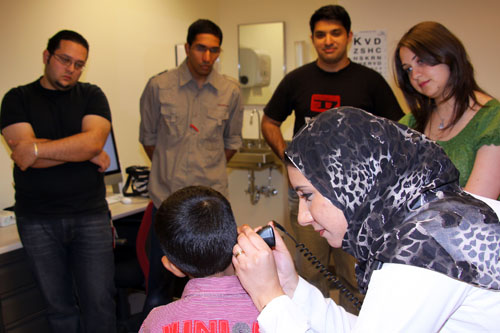Handle with Care
Students Learn from Youngest Members of WCMC-Q Community
July 2010

HMC pediatric resident Dr. Laila Mahmoud, foreground, models part of
the physical exam on Dylan Serrao, 5, son of Diana Serrao in the Office
of Curriculum Support, for third year medical students.
When it comes to health care, young children are not just miniature adults. Their inability to communicate, their tendency to cry or be shy can challenge even the best pediatrician.
To help medical students learn how to work well with young patients, WCMC-Q faculty and staff members brought their children to the clinical skills center for a couple of hours last month. The 20 youngsters, infants to young primary students, were examined briefly by medical students under the watchful eyes of a parent and a skilled pediatrician.
The pediatric encounters were part of the “Introductory Clerkship” course that prepares students for clinical medicine, which occupies most of the third and fourth years of the medical program as students rotate through different specialties.
“Our goal is to show students some skills and techniques for approaching babies and young children in a quiet setting before they get to the hospital,” says Amal Khidir, MD, assistant professor of pediatrics and director of the pediatric clerkship program who organized the program.
The encounters took place in the clinical skills center exam rooms, which are set up like regular clinic exam rooms. In each, a pediatrician role modeled the age-appropriate way to approach a child, gave a brief demonstration of some parts of the physical exam, and then let students practice on the young volunteer. Basically, it involved interacting with the child, then listening to the heart or lungs or touching the tummy under close supervision.
While most of the children seemed happy, there were a few tears from some of the very youngest patients. Other children clung tightly to their parent, even during the exam. “That occurs in real encounters,” says Dr. Khidir. “We teach our students to be flexible as pediatricians usually are, to accommodate the child’s behavior, to comfort them, and convince them to be examined.”
Shyness, even tears, were not a problem. “We want our students to get a real sense of working with children, so we told the parents not to worry about behavior,” says Dr Khidir, who brought her children to the exams. “The students were able to see how pediatricians interact with children and their real life behaviors.”
The Introductory Clerkship course was launched four years ago, when the first class of medical students was getting ready for clinical rotations at Hamad Medical Corporation medical facilities in their third year.
Initially, the pediatrics part of the course was didactic instruction, or lectures, according to Dr. Khidir. “Then we started contacting faculty members personally to ask them to bring in their children, and we did demonstrations in a big lecture hall. We realized it was not interactive enough. Last year, we asked all the faculty and staff to let their young children participate. Parents brought in 15 children. This year, 20 children participated, and we named the program ‘Cornell Stars.’”
The demonstrations were conducted by WCMC-Q physicians Stephen Scott and Marcelina Mian and HMC pediatricians Sajjad Rahman, Magda Wagdy and Amal Haider. Hamad pediatric resident Laila Mahmoud also gave demonstrations to students.
“It’s a really positive program in many ways,” says Dr. Khidir. “It’s very helpful to the students and it is another opportunity for collaboration between WCMC-Q and HMC. It gives a resident an opportunity to serve as a teacher, and it lets family members participate in WCMC-Q’s education mission,” says Dr. Khidir.
Report by Kristina Goodnough
